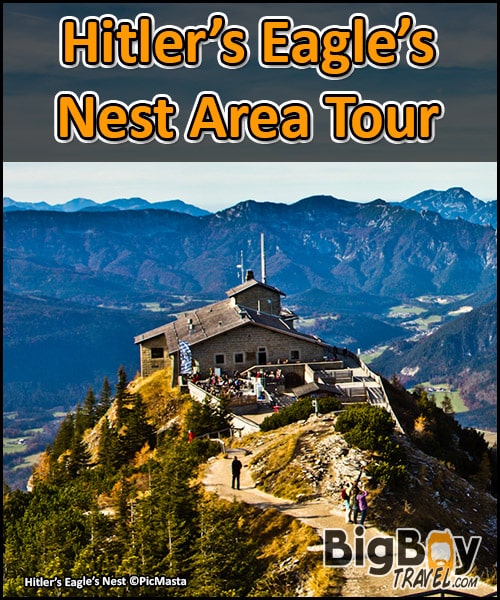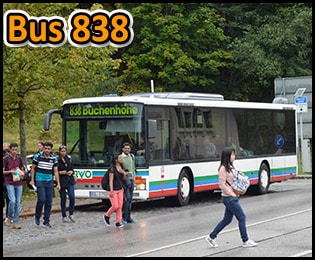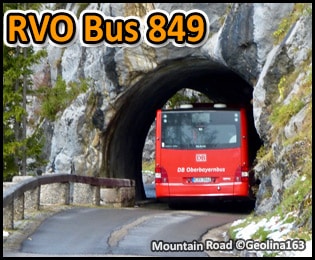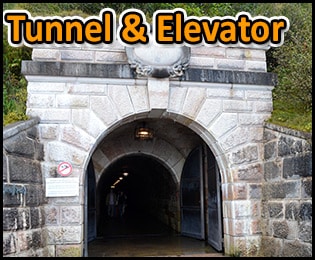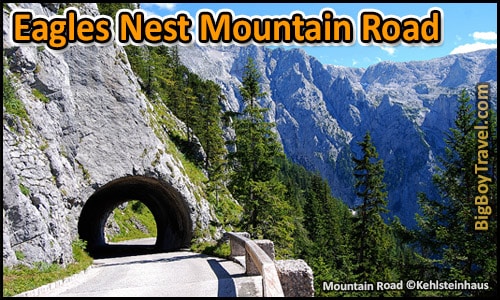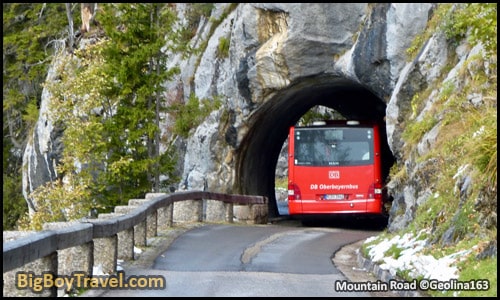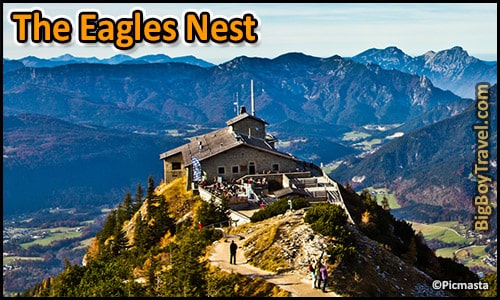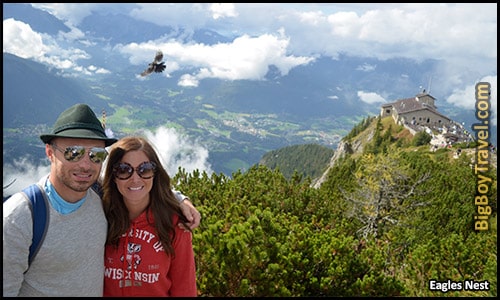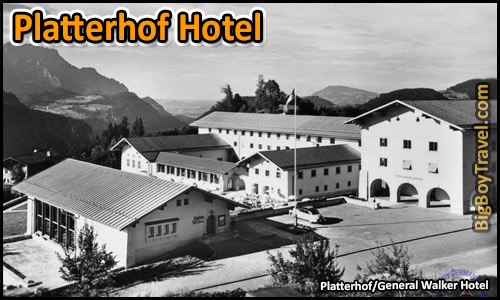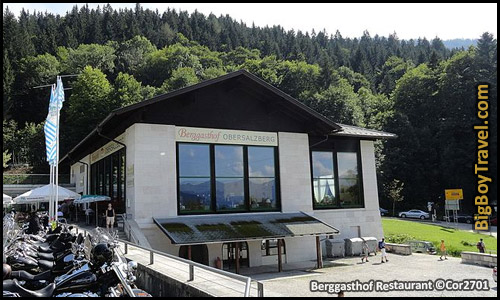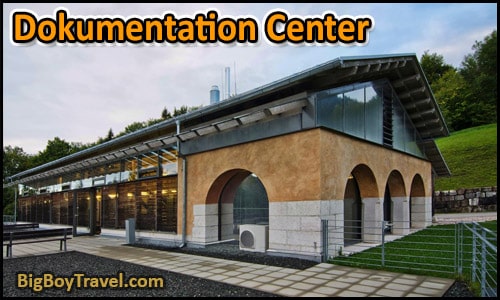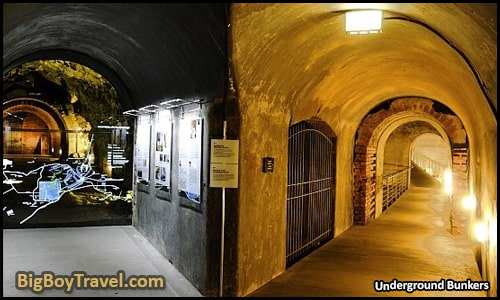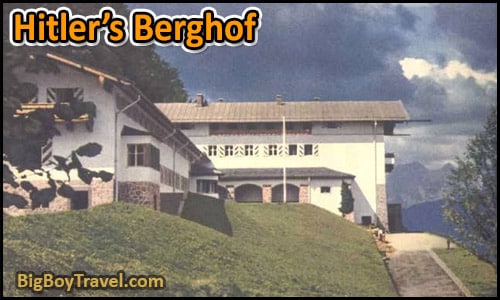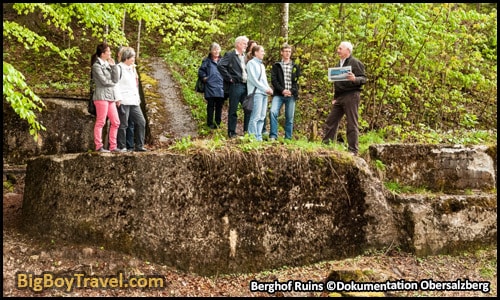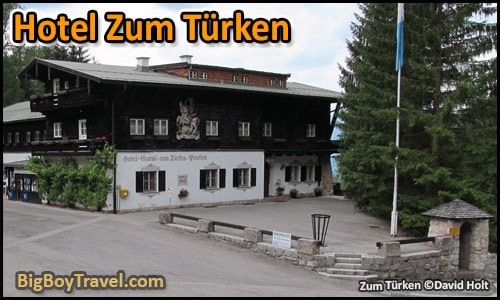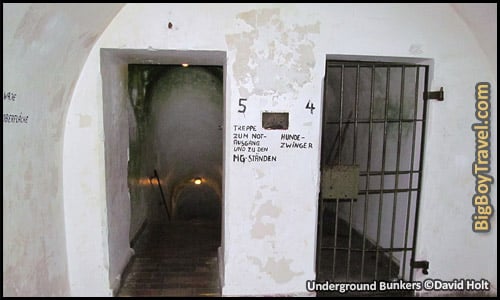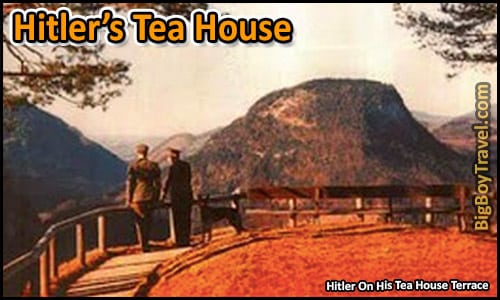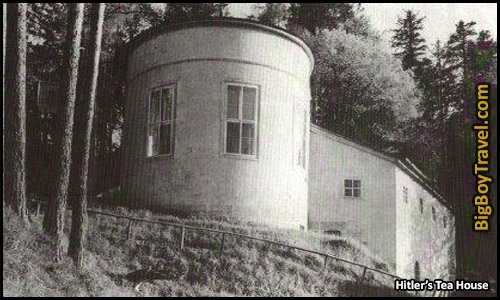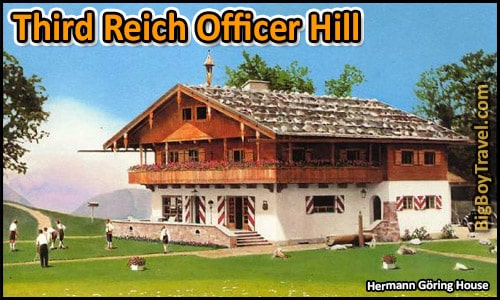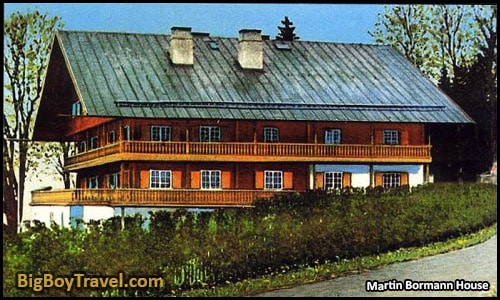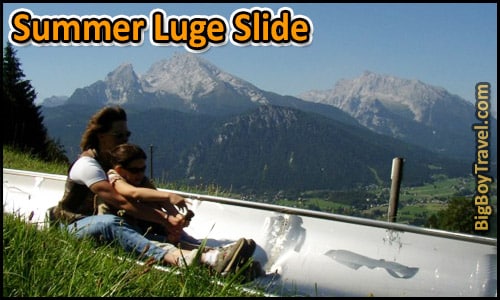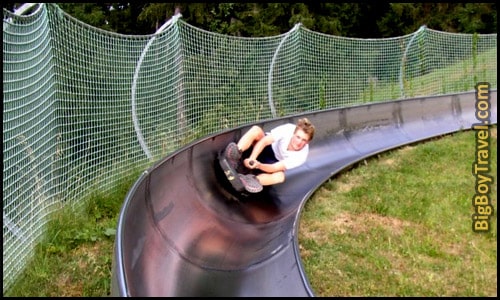Hitler’s Eagle’s Nest Tour & Area Sites:
Location: Obersalzberg Mountain above Berchtesgaden
Cost: 21€ for Adults, 15€ for Children for Local Bus + RVO Bus
Time Required: 3 hours round-trip from the Berchtesgaden Train Station to visit the Eagles Nest (+2-3 hours for Obersalzberg sites & Museum; +1 hours with luge slide visit)
Fun Scale: 9.5 out of 10
The lore of the mountaintop Eagles Nest, Dokumentation Center Museum, Hitler’s teahouse, secret bunkers, and Nazi command centers draw in WW2 history buffs to Berchtesgaden from all over the world. With 120-mile-views and tons of green space, most of these WW2 sites are on the hillside of Upper Salt Mountain (Obersalzberg) overlooking the village. Not only did the Alpine beauty of this area inspire Hitler’s writing, but it also became the place he spent 1/3 of his time in power, more than any other location. Even without learning about the WW2 history, the gorgeous Obersalzberg area is a must visit while you are in Berchtesgaden.
Closures In The Winter:
While the Nazi Dokumentation Center Museum & Bunkers stay open year round, the rest of the sites on Obersalzberg Mountain close November-April each year. These high elevation closures for Winter include Hitler’s Eagles Nest, Berghof Bunkers below Zum Turks Hotel, and the Summer slide luge.
How To Get to Hitler’s Eagles Nest:
Step 1: Berchtesgaden Train Station > Obersalzberg Dokmentation Center (Bus 838)
Step 2: Obersalzberg Eagles Nest Ticket Booth > Eagles Nest Parking Lot (RVO Bus 849)
Step 3: Eagles Nest Parking Lot > Eagles Nest (Tunnel & Elevator)
Overview of Obersalzberg During WW2:
The Eagles Nest Area Attractions:
1. Eagles Nest Mountain Road (Kehlsteinstrasse):
About Eagles Nest Mountain Road: Completed in late-1938 after only 13 months of cutting through solid rock, the Eagles Nest Mountain Road is a marvel built by Nazi engineer Martin Bormann. The 4-mile long road climbs over 700 meters (2,297 feet) up at a 27% incline with 5 tunnels and only 1 switchback. Because of the steep cliff drop-offs, there simply wasn’t room to use more switchbacks making the road that much more impressive.
The journey up the mountain road by bus is very exciting (not scary) and offers amazing views. Because most of the road is only one lane, expect that your bus will stop a couple times to wait for oncoming buses to pass. The steep one-lane mountain road is closed to the public, originally for security reasons and later for safety. With the route closed to public traffic, the only way to reach the Hitler’s famous Eagles Next (outside of a 2-hour strenuous hike) is by the special RVO Bus 849 which whizzes you up the mountain. Remember that this bus (nicknamed the Eagles Nest Bus) requires a standalone ticket bought at the booth in Obersalzburg (see map above) even if you have a bus pass for Berchtesgaden’s local in-town routes.
2. The Eagles Nest (Kehlsteinhaus):
About Hitler’s Eagles Nest: With the best panoramic views in Germany, the Eagles Nest is by far the top attraction in Berchtesgaden. Perched almost 3,000 feet above the surrounding valley floor, on a clear day you will able to see up to an unbelievable 120 miles away! The entire Eagles Nest project from the mountain road to the Alpine chalet at the top was meant to be a gift for Hitler’s 50th birthday on April 20th, 1939.
Nazi engineer Martin Bormann carefully chose the location because he knew Hitler loved the views at the Teehaus he visited daily. It was no small feat as the tortuous road required 3000 workers to labor in dangerous conditions around the clock. While it took 13 months to build the 4-mile-long road, the chalet on top was actually completed a year earlier in the Fall of 1938.
The interior of the chalet was lavishly decorated including a marble fireplace that was a gift from Italian dictator Mussolini. There was also a decadent carpet which was a gift from Jananese Emperor Hirohito. As amazing as the chalet was, however, Hitler only made 14 official visits up to the Eagles Nest and most were in the first year. That’s pretty odd seeing how he spent almost 1/3 of his time in power at his Berghof in the nearby Obersalzberg Complex. His first visit was on September 16th, 1938 last and the last was October 17th, 1940 even though he stayed in Obersalzburg through much of 1944. The most common reasons we have heard to why this was is because Hitler didn’t like the change of air pressure from the high elevation at the Eagles Nest and that he was afraid of being hit by lightning in the elevator. Although Hitler himself didn’t tour the site often, his mistress Eva Braun frequented the Eagles Nest. Eva’s sister Gretl even had her wedding reception at the chalet in 1944.
Thanks to the cover of a light dusting of snow the day before, the Eagles Nest was spared from British bombings on April 25th, 1945, but it didn’t escape unharmed. When American and French troops arrived many soldiers chipped souvenir pieces off the building’s stone facade and took almost everything inside. Unlike most of the Obersalzberg Complex, this Nazi building wasn’t demolished and instead was turned into a restaurant in 1952. The Eagle’s Nest Restaurant has good food, an unbeatable patio, but can get a little crowded in the afternoons, especially if it is a clear day.
At the entrance of the Eagles Nest, you get to use the same long tunnel that Hitler used to access the high-speed elevator. After a slick 407-foot journey straight up the shiny brass embellished elevator, you arrive at the chalet. Some visitors like the long hike from the Eagles Nest entrance to the top, but we suggest taking the elevator. Once at the hop though make sure to take the gradual hike up 300 feet above the chalet to the summit of the peak marked by the Mountain Cross. It is here at the Mountain Cross where you will be able to take the iconic photos back toward the Eagles Nest with the valley below. You will also be able to see cement platforms from two of the four 3.7cm guns that protected the chalet from air attacks. There were at least 14 batteries built around Berchtesgaden with heavy flak guns between 1943 and 1945.
Seasonality: Due to its high elevation the Eagle’s Nest is open in summer only, usually from about mid-May through October. Getting To The Eagle’s Nest By Bus: The easiest way to get here is to take the RVO Bus from the Documentation Center’s Hintereck Parking lot which leaves every 25 minutes from 7:40am-4pm and costs 16.10€ for Adults, 9.30€ for Children. Getting To The Eagle’s Nest By Hiking: You can get to the Eagles Nest by Alpine hiking on one of two well-marked trails illustrated on our map above. From the Ofneralm Parking Lot, it is a 1.5-2 hour long strenuous hike up. From the Scharitzkehl Parking Lot in about 3-hour hike. If you don’t have a car take the 383 bus to the end of the line at the Christophorusschule (Gymnasium) Stop near the Scharitzkehl Parking Lot. You can also catch this trail near the Luge mentioned below cutting your hike down to 2 hours. Cost: Hitler’s Eagles Nest is now a restaurant and there is no cost for visiting. The high-speed elevator is free. Website: Here.
3. Platterhof Hotel & Cottage of Struggle:
About The Platterhof Hotel: As you step off of Bus 838, the first building you reach after crossing the street from the stop is the former Platterhof Hotel. Originally built as the Steinhausen, Mauritia “Moritz” Mayer bought the property in 1877 and opened it as the Pension Moritz. The hotel quickly began to host celebrity guests, and Moritz became a pioneer of modern tourism in Germany and Central Europe. The hotel’s nickname Platterhof came because Moritz had inspired the character of author Judith Platter in Richard Voss’ famous novel Zwei Menschen (Two People) from 1911 which later became a movie.
Hitler first starting coming to Berchtesgaden in 1923 when he would meet his friend and mentor Dietrich Eckart at Platterhof under the name Herr Wolf. He quickly fell in love with the Obersalzberg area calling Berchtesgaden his New Chosen Homeland (Wahlheimat). After getting out of the cushy Landsberg Prison in December 1924 from his failed Beer Hall Putsch in Munich, Hitler soon came back to Berchtesgaden renting a rustic cabin in the woods across the road from the Platterhof. Known as the Cottage of Struggle (Kampfhäusl), the cabin was where Hitler finished writing Mein Kampf (My Struggle).
Much of Hitler’s political manifesto had written in prison, but was in his Cottage of Struggle that the two sections of his rambling propaganda book were finetuned to express is radical ideology and future plans for Germany. The push to finish Mein Kampf came after Hitler was banned from public speaking in Bavaria for two years because of violent language in a speech 0n February 27th 1925 in Munich’s Bürgerbräukeller (site of the failed Putsch) meant to reboot the Nazi Party. During this time, Hitler knew that the written word was the best way to get out his radical messaging. While the wooden cabin is long gone, the stone foundations Moll bunker ruins can easily be visited with a very short walk behind the power station hut along the road.
During the Nazi occupation of Obersalzberg (1933-45), the Platterhof Hotel was expanded by the government and remolded into deluxe accommodations for high ranking Nazis and dignified guests. Unlike many other buildings on the mountain, the hotel wasn’t torn down by the city in 1952 and instead became the Hotel General Walker after renovations by the US Army. This change included turning the former Terrace Hall into the Skyline Restaurant.
The property was given back to the city of Berchtesgaden in 1995 but torn down most of the hotel in 2000 including its courtyards. The only remaining part of the Platterhof is the former Terrace Hall (later Skyline Restaurant) which has now been turned into the Berggasthof Restaurant (website). The rest hotel had been quite large, was connected to underground bunkers, and used to take up most of the restaurant’s parking lot.
4. Dokumentation Center & Bunkers:
About The Dokumentation Center: Sitting on the site of today’s Dokumentation Center Museum was once the Alpine hotel called Gästehaus Hoher Göll. After becoming German Chancellor in 1933, Hitler (who lived next door) started seizing neighborhood homes and hotels to create a vast 80 building compound here known as the Obersalzberg Complex. The Gästehaus Hoher Göll was incorporated into the Obersalzburg Complex in 1934 and renovated into offices for the staff of Hitler’s right-hand man Martin Bormann.
The Obersalzburg Complex was declared a military-only area in 1936 and became the official second seat of the 3rd Reich government known as the Führer’s Security Zone. Secret Nazi plans were hatched out at the complex and Hitler spent around 1/3 of this time in power at the compound, more than any other location.
When the Nazi’s lost the Battle of Stalingrad in 1943, they built a 4-mile-long bunker system under the Obersalzberg Complex for added security. The bunkers held meeting room, lavish apartments, and served as air raid shelters, underground shooting ranges, archive storage, and food reserves. Both the Gästehaus and Platterhof Hotels shared a joint section of the Obersalzberg bunkers, and they were connected to the Hitler’s private Berhof bunkers by an elevator shaft another 30 meters (100 feet) deeper. There was even an additional 1-mile-long uncompleted bunker called Obertal another 100 meters (338 feet) below the Berghof bunkers. The Obertal bunker would have been like an underground highway connecting to the Gusthof farm in Obersalzberg for access to Berchtesgaden in one direction and Salzburg the in other direction.
On April 25th, 1945 much of the Obersalzberg Complex was bombed by the British Airforce but the bunker system was unhurt. Over 3000 people sheltered in the bunkers and only 12 people were killed in the bombing. Berchtesgaden surrendered on May 4th and by the time US troops arrived on Obersalzburg the next day looting had already begun on the Nazi buildings. Wine, cigars, and furniture were plundered from the basements and bunkers, but no shots were fired.
The US Army kept the hillside on lockdown through 1949 and still occupied much many building on Obersalzberg until 1995. In 1999, the local government built a museum on the ruins of the former Gästehaus Hotel so the citizens could learn from the past and never repeat it. This preservation was a welcomed move by historians as when the city had been given control of six other former Nazi buildings in 1952 they demolished them out of fear they may be glorified.
The original foundation of the former Gästehaus Hotel and large sections of the Nazi’s underground bunker system were tastefully incorporated into today’s Dokumentation Center Museum. From the outside, you can see the three tan stone archways on the end of the museum which were part of the original building. Going on a self-guided tour of the underground bunkers truly feels like you are stepping into the past, or at least an old James Bond film. We find the informational exhibits at the museum to be fascinating and very educational. The Dokumentation Center Museum was built to accommodate 30,000-40,000 annual guests but had to be significantly expanded in 2016 since they get four times the amount of visitors they initially expected.
Cost: 3€ for Adults, Children Free. Hours: April-October Daily 9am-5pm; November-March Tuesday-Sunday 10am-3pm, Closed Mondays in Winter. Audio Tours: English audio guide tour available for rent 2€. Guided Tours: Available in English Mid May-October, you may book ahead of time HERE. Website: Here.
5. Hitler’s Berghof Ruins:
About Hitler’s Berghof: Just a short wooded stroll up from the Nazi Documentation Center Museum brings you to the ruins of the Berghof mansion where Hitler spent 1/3 of his time in power, more than any other location. From his first visit in 1923, the beauty of Obersalzburg above Berchtesgaden had attracted Hitler who was also an inspiring artist most of his life. By 1928 Hitler started renting a small 5-room rustic vacation cottage on this site called Haus Wachenfeld (built 1916). He fell in love with the views of Untersberg Mountain which mythology says Charlemagne lays resting in an ice cave ready for the re-birth of the Holy Roman Empire (abolished 1806). After becoming German Chancellor in 1933, Hitler bought the Haus Wachenfeld to become his primary home and began expanding it into his Mountain Court (Berghof).
The Berghof grew from the small Haus Wachenfeld into a 30-room mansion, with outdoor stone terraces, a lavish great hall (60×50 feet), bowling alley, expensive tapestries, 24-person dining room, and a huge 90-pane retractable window wall. The expansion of the property into the Berghof compound was the start of a new Nazi military complex fanning out along Upper Salt Mountain (Obersalzberg). By 1936 the Obersalzburg Complex became a secure military zone and complete with an extensive network of underground bunkers. By 1943 there were 4 miles of shelters with Hitler’s private bunker section below Berghof ranging from 100-200 feet deep, with 44,000 square feet of living space, a dog kennel, a kitchen, archives, and many military operation elements.
Joining Hitler at Berghof were his mistress/wife Eva Braun and their dogs including a German Shepard named Blondi. Hitler had met Eva in Munich in 1929 (she was 17, he 40) where she was a model and assistant to his photographer. For much of WW2 Eva stayed at the Berghof and was relatively sheltered from the more delicate details of the war. With Hitler often away from home she twice attempted suicide with his gun in what were believed to be pleas for attention. Some of the frustration was because Hitler refused to marry her believing it would reduce his attractiveness to women in his ongoing pursuit to control people with his image.
From the time Hitler became the German Reich Chancellor in 1933, hoards of his “fans” including thousands of children would flock to the Berghof. As many as 5,000 people a day would come to the entrance of the property in the Summer to try to get greeted by the Führer. Hitler’s celebrity was growing, and he would even sign autographs here as he routinely welcomed his visitors midday. As the Nazis bought the hillside (was more of a seizure), Obersalzberg became a restricted area for security. There was also a significant SS guardhouse gate on the road below the Berghof which served as the primary entrance into the estate.
There were many famous guests at Berghof including British Prime Ministers David Lloyd George in 1936 and Neville Chamberlain who came to negotiate a peace treaty in 1938. These meetings led to the Munich Agreement which then handed vast parts of Czechoslovakia over to Germany in exchange for a peace that never happened. Other guests included Duke Edward and Duchess of Windsor, Italian Prime Minister Benito Mussolini, King Carol II of Romania, and many Many Ambassadors. That meeting in 1937 with Duke Edward of Windsor was one of the most famous as he had abdicated the throne as King Edward VIII of England the previous year after only 10 months because he wanted to marry a divorced woman. Although he wasn’t pro-Nazi, Edward supported Hitler and even did the Nazi salute during his visit in hopes of being put back on the throne if the United Kingdom was conquered.
Hitler left Berghof on June 15th, 1944 for the Eastern Front in Poland and then spent the last few months of the war in Berlin. On April 15th, 1945 Eva Braun also left Berghof to join Hitler (5 days before his birthday) in his Berlin Bunker even though the Soviets troops were getting near the capital. Just 10 days later Berghof and much of the rest of Obersalzberg was severely damaged by British bombers. Somehow only 12 people were killed as over 3,000 including one of Hitler’s top generals hide in the underground bunkers. On the 29th of April, 1945 Eva and Hitler were finally married inside the Führerbunker in Berlin, and just 40 hours later the couple committed suicide (she was 33, he 56) with the Soviet Red Army closing in on them.
With Berchtesgaden surrendering on May 4th, 1945 the Berghof was looted and set on fire by retreating Nazi troops as they left Obersalzburg. The next day US troops planted their flag on the hillside and finished the rest of Hitler’s remaining wine. It’s said that the fire did more damage to the Berghof than the bombs did leaving the compound as a burnt out shell. To deter sight-seers and neo-Nazis, the Bavarian government demolished the remaining shell of the Berghof complex on April 30th, 1952 (the 7th anniversary of Hitler’s suicide).
Even after the US Army gave Obersalzberg back to Berchtesgaden in 1995, you could still go into some of the tunnels directly below Berghof until they were cemented shut in 2013. The only public sections left of his private bunkers that can be visited are at the Zum Turks Hotel which is next on this Third Reich locations tour.
6. Hotel to the Turks (Zum Türken):
About Hotel Zum Türken: There has been a cozy Alpine lodge at this pristine location since the Little Turk House (Türkenhäusl) was built here in 1630. The nickname came from the original owner who was a veteran of the Turkish sieges on Vienna (1529-1683). He really did pick the perfect spot as this wonderful building has unmatched views of the surrounding mountains.
In 1903, Karl Schuster bought the Little Turk House and within eight years remodeled it into the guesthouse Zum Türken complete with its own butcher shop. Previous to this, Schuster was also the innkeeper at the Purtschellerhaus am Hohen Göll which still sits nearby on the German/Austrian border. The Zum was a huge success attracting famous guests like German composer Johannes Brahms, the Crown Prince Wilhelm & Princess Cacilie of Prussia, and Prince-Regent Luitpold of Bavaria.
As Hitler moved in next door in 1928 and started buying up all of the buildings on the Obersalzberg mountainside near Berghof, Schuster refused to sell Hotel Zum Tuerken. Karl Schuster was outspoken against the Nazis and wasn’t happy that the presence of SS Troop at his neighbor’s house was hurting his hotel business. To force him to sell, Hitler sent Schuster to serve 3 weeks as a prisoner at the Dachau Concentration Camp and the property was forcibly seized by the Nazis. During the World War Two, a Nazi SS Guard post (still there) and gate were set up on the edge of the parking lot and the Zum Tuerken was used to house troops.
The property was heavily bombed in WW2 after which the Schuster/Scharfenberg family had to fight to re-buy their damaged home so it wouldn’t be torn down by the government. Crazy to think they had to fight to re-buy their own home which had been taken from them just a decade earlier. After finally getting their home back, the family repaired it and are on their 4th generation running the hotel. While the hotel has no wifi, it has cozy rooms, great hospitality, has a wonderful terrace for taking in the Alpine air, and is in a great location to go hiking.
Below the hotel is a large section of intact underground bunkers built in 1943 as air raid shelters and are open for the public to tour. This section of bunkers was once connected to Hitler’s Berghof next door, his underground apartments, and served as a secret escape exit. On a tour of the underground bunkers, you can see the bricked up entrance that once led to Hitler’s Berghof, can peek into some defensive gun windows, and see three underground jail cells. In total there were 6 separate bunker systems (bunkeranlagen) with over 4 miles of tunnels in Obersalzberg all of which were 100-300 feet below ground. The multi-level network of tunnels provided air raid protection for thousands of people if necessary. These deep bunker systems protected 3,000 people in Obersalzberg during British bombings with only 12 people dying.
Keep in mind that if you visit the bunkers that this is a real mom and pop hotel business run by a hard-working family. You need to be respectful and remember that their home was forcibly seized during the war, it was bombed, and they had work very hard for generations to get their amazing hotel back to where it was before the occupation. Please don’t park in their parking lot or try to enter the hotel lobby as both are reserved for guests only. For the privacy of the family and hotel guests, don’t gawk or take selfies at the property.
Bunker Tours: Mid-April through October they are Wednesday-Monday 10am-3pm, Closed Tuesdays; Christmas through mid-January they open daily 11am-3pm; Closed the rest of the year. Bunker Tour Entrance: Note that the hotel lobby is locked and for guests only. There is a special entrance on the side for the bunker tours with a large sign that says Bunkers Entrance (Eingang Bunkeranlagen). Hotel Seasonality: Open May-October; Closed November-April. Minimum 2-night stay. Website: Here.
7. Hitler’s Tea House (Teehaus):
About Hitler’s Tea House: Located on Mooslahnerkopf Hill near the Berchtesgaden Golf Course was once Hitler’s famous Teehaus built in 1937. On a daily basis around 10am, Hitler would take a 10-15 minute afternoon stroll from his Berghof to the Tea House with his dog to relax and nap. Often people incorrectly call the Eagles Nest chalet (which he rarely visited) Hitler’s Tea House when it was really a much smaller building located here.
In 1944, the Tea House was chosen by the British military for an assassination attempt on Hitler called Operation Foxley. They had considered bombing his train and poisoning his tea but settled on using a sniper during Hitler’s morning walk to the Tea House. The route of the stroll and insight that Hitler preferred not to be closely followed by his guards was revealed by a former person guard captured in the invasion of Normandy. Although approved, ultimately the British canceled the sniper plan believing the war would soon be over and they didn’t want to make Hitler a Nazi martyr. The last time Hitler would make his morning walk was on 14 July 1944 before heading to the Eastern Front. There had been dozens of close assassination attempts on Hitler going back to 1921 by both internal and external forces. The most famous was called Operation Valkyrie on July 20th, 1944 at the Wolf’s Lair (Wolfsschanze) on the Eastern Front in Poland where a briefcase bomb was set off in a high-level meeting.
The Tea House building was spared by British bombing in 1945 but was destroyed in 1952 along with other Nazi buildings in Obersalzberg for their association with Hitler. The shell and rubble of the building weren’t cleared out until 2006, but the terrace and park bench 100 feet in front former Teehaus still offers excellent views. In Hitler’s day, what is now the golf course’s 13th hole below the Teehaus was once a meadow for the Nazi Estate Farm (Gutshof). Make sure to walk along the path curving around the golf course and do not walk directly across the fairways as it is private property and an active golf course.
8. Third Reich Officer Hill:
About Officer Hill: The hilltop overlooking Hitler’s Berghof was mostly undeveloped on the surface, but was an essential part of the Nazi’s Obersalzberg zone. In addition to having the area’s most extensive network of underground bunkers, the hill was also home to two of Hitler’s Third Reich cabinet ministers who were among the most powerful people in the Nazi Party. Across the street from the Turk’s Hotel was the home of Nazi engineer Martin Bormann and further up the hill was a chalet for Reich Marshal Hermann Göring.
Martin Bormann quickly moved up the ranks of the Nazi military to serve as both Hitler’s personal secretary and a Third Reich cabinet minister. He was in the inner circle very early as Hitler’s right-hand man with Adolf even serving as a witness in Bormann’s 1929 wedding. After overseeing the expansion of Hitler’s Berghof, Bormann became responsible for the rest of the development in Obersalzberg and became the Nazi’s moneyman. In Obersalzberg Bormann built the SS Barracks, Eagles Nest Mountain Road, Estate Farm (Gutshof), bunkers, and the Greenhouse (Gewächshaus) which was important as Hitler was a vegetarian.
Being in charge of the Nazi’s money, Bormann helped make Hitler a millionaire through book sales and image royalties from stamps. In exchange for his service, was given the home of local Doctor Seitz on the hill across the road from Turk’s Hotel with a clear sight of Berghof below. Under the underground Bormann had a massive maze of a private bunker with an air raid shelter and underground military communications center. He gained so much power that while Hitler focused on the Eastern Front, Bormann became in charge of all domestic policy.
In the closing days of the war, Bormann was a witness for the marriage of Eva Bran and Adolf Hitler in Berlin’s Führerbunker just 40 hours before the newlyweds killed themselves. During this time in Berlin Bormann’s wife and 9 children remained in Obersalzburg. Bormann was willed Hitler’s estate, was named the minister of the Nazi Party, and famously went missing inspiring a multi-decade manhunt.
Unlike his close associates Adolf Hitler, Joseph Goebbels (Minister of Propaganda), and Heinrich Himmler (architect of the Holocaust) chose to kill themselves at the end of the war, Bormann attempted to escape under cover of nightfall in civilian clothes right before Berlin fell. Although he wasn’t there in person, Bormann was sentenced to death with his high ranking colleagues in late-1945 at the Nuremberg Trials. Finally, in 1972 two skeletons were found during construction near the Weidendammer Bridge at Lehrter Station (1871-1951, now Hauptbahnhof) in Berlin. The bones matched with both medical records, medical records, and in 1998 DNA confirmed it was indeed Bormann died of self-induced cyanide during his escape attempt.
Unlike most of the buildings which were seized by the Nazis, Hermann Göring’s home (Göringhügl) was built brand new as a gift from the Third Reich in 1933. Göring was a decorated WW1 veteran, served under the famous Red Barron, was shot in the groin during Munich’s failed Beer Hall Putsch in 1923, founded the Gestapo secret police in 1933, and in 1940 ordered the bombing of British civilians in what became known as The Blitz. The Blitz was also the campaign that forced France to surrender to Germany. Göring dispised Bormann as he had always seen himself as Hitler’s successor, but had to go along with it.
One passion that had Göring and Bormann agreed upon was getting rid of the Jewish people from the territories they were conquered in the war. They served as go-betweens so Hitler could keep his hands clean of the mass murder and concentration camps which were in full swing by 1942. The men were at the heart of the Nazi terror machine and Göring benefited by collecting treasure troves of artwork. In the closing days of the war, Göring tried to hide much of his pirated art collection in a bunker tunnel behind the Berchtesgaden train station. Göring and his family were at Obersalzburg when it was bombed on April 25th, 1945 and survived in his bunker. He was the highest-ranking defendant during the Nuremberg Trials of late-1945 and was sentenced to hang, but killed himself with cyanide before his pending execution.
Sitting in between Göring’s house and the Greenhouse was Göring’s Hill (Göringhügl). This hill was the tallest point in Obersalzberg and below the ground were the extensive private bunkers for Bormann and Goring along with a military communications center. This was the spot that the US Army 3rd Infantry Division raised their flag on May 5th, 1945 similarly to how troop had raised the flag in Iwo Jima that February.
When the fancy Intercontinental Hotel (now Kempinski Hotel) was built over the bunkers in 2002 there was pushback on the hotel’s location and bulldozing of the top of the hill were in bad taste. Because of this, the hotel was nicknamed the Hitler Hilton. In 2008 on the 63rd anniversary of the planting of the US flag here a ceremony took place with 3 vets who were there to replant a flag and add a plaque honoring along with the mayor of Berchtesgaden.
9. Summer Luge Slide (Sommerrodelbahn):
About The Sommerrdelbann Luge: Family fun awaits at Sommerrodelbahn’s 2,000-foot-long metal Luge which speeds down the mountain. After whizzing down the hill the track automatically shuttles you back up to the top for more fun. It is probably impossible to only to one trip on the Luge as it is so fun you’ll want to do it at least 2 or 3 times. The Maltan Family that runs the Luge also runs a beautiful hotel and beer garden nearby if you are looking for Berchtesgaden accommodations. In addition to a great location, the rooms are some of best priced in town.
Getting To The Luge By Bus: The easiest way to get here since you are already up the hill is to take Bus 838 directly to the Sonneck stop which is right outside the Luge. Getting To The Luge By Alpine Lift: There is also a convenient Alpine lift that goes right from Berchtesgaden up to the Luge. The lift is probably the easiest way to get back down to Old Town from the slide. Slide Hours: April through early-November 10am-6pm; Closed when wet; also closed in Winter. Ride Cost: 1 ride is 2.50€ for Adults or 2€ for kids. Discounts for multiple rides with 18€ for Adult rides 10 as an example. Combo Ticket: You can buy 3 rides plus round trip on the cable car up the mountain for 13€. Website: Here.
10. Former SS Guardhouse:
About The SS Guardhouse: Riding the cable down the from the Summer slide luge you’ll cross the river and be dropped off right next to one of Berchtesgaden’s form SS Guardhouses. The small hut was built in 1937 at the intersection of the riverfront road between Salzburg and the Berchtesgaden train station with the drive up to Obersalzberg. The build date can be seen on the front of the guardhouse which also once had a carving of the Third Reich’s eagle symbol. This hut was the first of three guardhouses on the route of the Hitler’s Berghof and is the last one still standing.
11. Berchtesgaden Train Station (Bahnhof):
About The Train Station: Much of Hitler’s success as a leader was based on portraying a particular type of grandiose image, which can also be seen at Berchtesgaden’s train station. Berchtesgaden’s small train station was greatly expanded in 1937. For comparison sake, the new station was even bigger than the train station in Athens Greece at the time.
The Western wing was an expanded post office called the Berchtesgaden Postamt. You can still see a huge mosaic on the corner of the exterior of a victorious man holding a wreath flag and shield with the crest of Berchtesgaden. During the occupation, the inside of the wreath had the Nazi blood flag and swastika which was quickly changed in mid-1945. Today the former post office is home to a Burger King and a popular Burger King-run hostel which we have stayed at.
The sizeable Eastern wing of the train station was built as a Nazi reception hall to impress important guests arriving in town. The reception hall was filled with beautiful furniture and art taken from galleries in Vienna. It’s said that Hitler and his driver would pick special guests up here in his convertible car. Today the interior of the train station has Berchtesgaden-themed murals from the 1950s that have replaced similar ones from the Nazi era.
On the Eastern end of the station, the tracks start to lead north and hit a large tunnel constructed in 1940. This line was going to connect Berchtesgaden directly to Salzburg, but the line was never completed. The side of the tunnel’s entrance bears its date and it once also had Nazi symbols.


